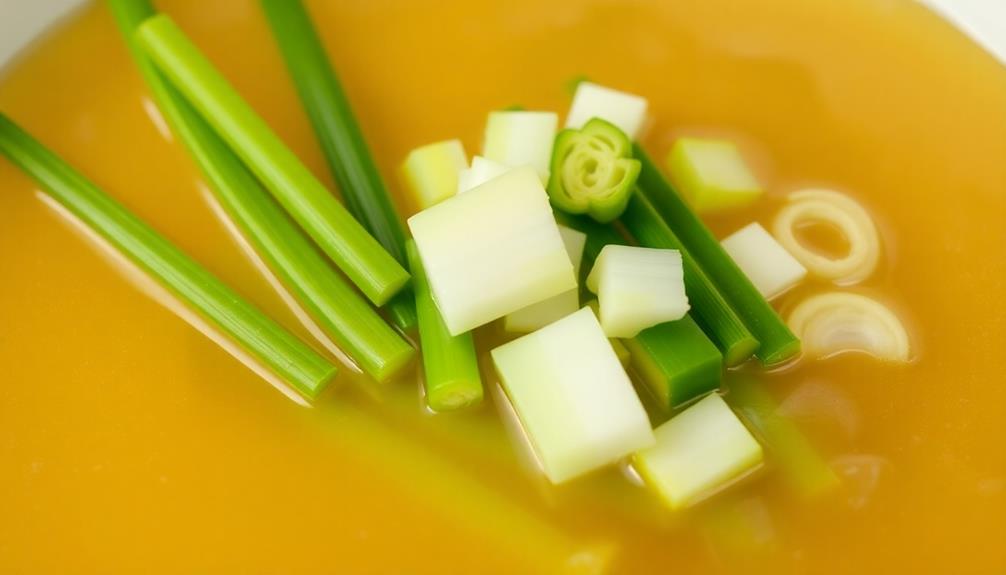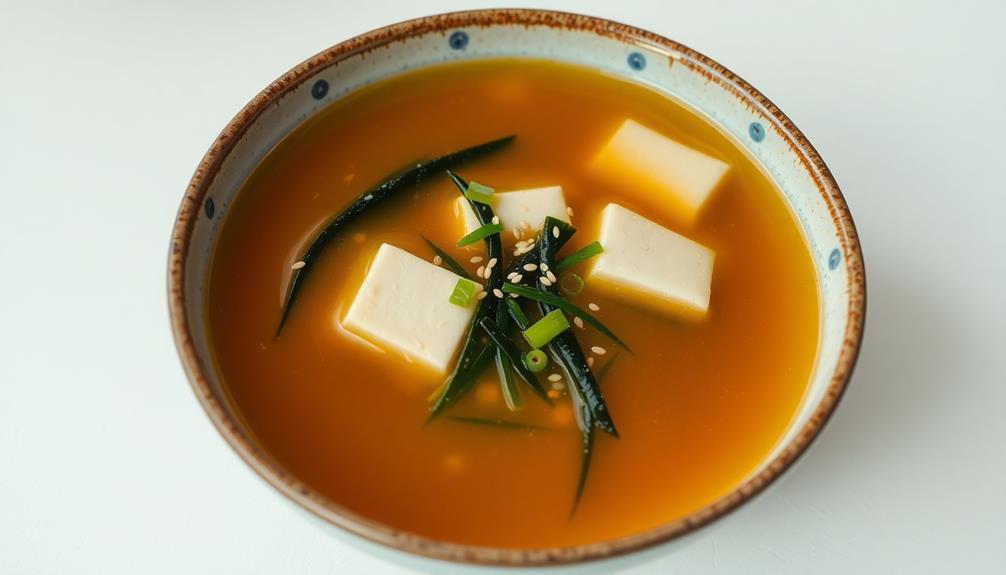Miso soup, a savory Japanese staple, is a daily delight! This umami-rich broth, made from fermented soybean paste, dashi, and tofu, is packed with probiotics and nutrients. The flavor can range from mild and sweet to robust and salty, depending on the miso used. Miso soup symbolizes comfort and home-cooked meals, often served at breakfast in Japan. It's quick to prepare, with the miso whisked into simmering dashi, then topped with cubes of soft tofu and fresh scallions. This simple yet satisfying soup reflects the importance of umami in Japanese cuisine – and there's so much more to discover about this beloved dish.
Key Takeaways
- Miso soup is a traditional Japanese soup, originating in the 7th century, made from fermented soybeans, salt, and koji mold, along with dashi and tofu.
- Miso soup is rich in probiotics, high in protein, and low in calories, making it a healthy option that promotes gut health and provides essential nutrients.
- In Japanese culture, miso soup is commonly consumed as part of breakfast and symbolizes comfort, home-cooked meals, and the importance of umami in Japanese cuisine.
- The basic recipe for miso soup involves dissolving miso paste in simmering dashi stock, adding tofu cubes, and garnishing with sliced scallions for a savory, umami-rich broth.
- Miso soup has regional variations with unique types of miso, and its popularity has led to the development of instant miso soup products for global accessibility.
History
The origins of miso soup can be traced back to ancient Japan, where it served as a staple in the traditional diet. Centuries ago, Japanese farmers and villagers would gather local ingredients like seaweed, mushrooms, and vegetables to create savory broths and pastes – the very foundations of miso soup.
Over time, the recipes evolved as different regions developed their own unique miso varieties. Some were made with rice, while others used barley or soybeans. Each type had its own distinctive flavor, from the sweet and mild white miso to the robust and salty red miso.
Miso soup became a beloved part of the Japanese culinary heritage, nourishing both body and soul.
Today, this comforting dish remains a daily ritual, offering a delightful blend of umami flavors and cultural tradition. Whether you're enjoying it for breakfast, lunch, or dinner, a warm bowl of miso soup is a true taste of Japan. Not only is miso soup a staple in Japanese cuisine, but it also pairs perfectly with other traditional dishes such as the Japanese tamagoyaki recipe. The combination of the savory miso soup and the sweet, fluffy layers of the tamagoyaki create a harmonious balance of flavors that is beloved by many. In every spoonful, you can taste the rich history and cultural significance of these time-honored Japanese recipes.
Recipe
Miso soup is a traditional Japanese dish that has become popular around the world. It's a savory and umami-rich broth that's commonly served as a starter or accompaniment to a meal. The versatility of miso soup lies in its ability to be customized with a variety of ingredients to suit individual preferences.
Preparing a classic miso soup at home is a straightforward process that allows you to control the ingredients and flavors to your liking. With just a few simple steps, you can enjoy the soothing warmth and depth of this comforting dish.
- Dashi (Japanese fish stock)
- Miso paste (white, yellow, or red)
- Silken tofu, cubed
- Sliced green onions
- Enoki or shiitake mushrooms (optional)
In a saucepan, bring the dashi to a gentle simmer. Whisk in the desired amount of miso paste, adjusting to your taste preferences. Gently stir in the cubed tofu and any additional ingredients, such as mushrooms. Allow the soup to simmer for a few minutes, being careful not to boil, as this can affect the flavor of the miso.
Ladle the miso soup into bowls and garnish with sliced green onions.
When preparing miso soup, it's important to remember that the quality of the miso paste can greatly impact the overall flavor. Experiment with different varieties to find the one that suits your palate best.
Additionally, be mindful of the temperature when adding the miso, as excessive heat can cause the miso to lose its beneficial enzymes and probiotic properties.
Cooking Steps
First, you'll want to bring that dashi stock to a gentle simmer.
Then, stir in the miso paste until it's fully dissolved.
Next, add the cubes of fresh tofu and sliced scallions.
Step 1. Bring Dashi Stock to a Simmer

Next, bring your dashi stock to a gentle simmer. You'll want to keep a close eye on it, gently adjusting the heat as needed. As the liquid starts to bubble, you'll see tiny wisps of steam rising from the surface. This is a sign that the stock is heating up perfectly.
Maintain a low, even heat to avoid letting the dashi come to a full, rolling boil. You don't want it to get too crazy! Simmering gently is the key here. This allows the flavors to meld together beautifully without overcooking anything.
Once the dashi is simmering, it's time to add your miso paste. Whisk it in slowly, making sure it dissolves completely into the broth. The miso will give your soup that signature savory, umami taste.
Keep the heat low and let the soup simmer for a few more minutes, allowing the flavors to really develop.
Step 2. Add Miso Paste

Once the dashi is simmering, you'll want to carefully whisk in the miso paste. This is the magic moment where the soup transforms into a savory, umami-rich delight!
Take a spoonful of the hot dashi and mix it with a small amount of miso paste in a separate bowl. Whisk until the miso is fully dissolved, creating a smooth, creamy consistency.
Then, slowly pour this miso mixture back into the simmering dashi, stirring gently to incorporate. The miso should dissolve easily, but be careful not to boil the soup once the miso is added, as that can make the flavor too intense.
You'll notice the soup taking on a slightly cloudy, golden-brown hue as the miso blends in. Keep the heat low and continue stirring until the miso is fully incorporated.
This gentle process allows the miso's complex flavors to gently infuse the dashi, creating that signature miso soup taste. With the miso added, your soup is nearly ready to serve and enjoy!
Step 3. Add Tofu Cubes

After adding the miso paste, it's time to incorporate the tofu cubes into the soup. Gently slide the soft, white tofu cubes into the savory broth. Watch as they gently float and bob, absorbing all the delicious flavors. The tofu will add a wonderful creaminess to the soup, complementing the salty miso.
Be sure to use firm or extra-firm tofu for the best texture. Soft or silken tofu may disintegrate. Cut the tofu into bite-sized cubes, about 1/2-inch thick. This size allows the tofu to warm through without overcooking.
Simmer the tofu in the soup for just a couple minutes, until heated through. You don't want the tofu to become tough or rubbery. The goal is a soft, tender texture that melts in your mouth.
The tofu will soak up all the umami goodness, making each spoonful pure comfort.
Step 4. Add Sliced Scallions

Thinly slice the scallions, including both the green tops and white bottoms. You'll want to slice them into thin, bite-sized pieces so they'll disperse evenly throughout the soup.
The scallions will add a lovely, mild onion flavor and a pop of fresh green color. Gently add the sliced scallions to the miso soup just before serving. Their crunchy texture and subtle sweetness will complement the savory miso broth perfectly.
The scallions bring a delightful freshness that balances the overall dish. Their vibrant green hue also makes the soup look extra appetizing. Additionally, the scallions add a mild, onion-like flavor that complements the rich broth and tender pieces of chicken. This classic ingredient is a staple in the traditional recipe for rosół, a Polish chicken soup that is beloved for its comforting and soothing qualities. The scallions truly elevate the dish and contribute to its authentic taste.
Be sure to add the scallions at the very end, as you don't want them to overcook and lose their crunch. A sprinkle of these sliced green onions is the perfect final touch to your homemade miso soup, elevating the flavor and presentation.
Step 5. Serve Miso Soup Immediately

Freshness is paramount when it comes to miso soup. As soon as you've added the sliced scallions, it's time to serve this savory delight immediately. The bold, umami-rich flavors are at their prime right off the stovetop. Don't let them sit and lose their luster.
Carefully ladle the hot soup into individual bowls. The wispy steam rising from the surface is a tantalizing invitation. You'll want to dig in right away to capture that perfect balance of salty, savory, and slightly sweet.
The soft tofu and tender wakame seaweed should still have a delicate texture, not overcooked. Serve the miso soup while it's piping hot. This allows you to fully appreciate the depth of flavor in each sip.
The longer it sits, the more the ingredients will begin to lose their vibrancy. Enjoy this authentic taste of Japan at its freshest for a truly satisfying experience.
Final Thoughts
Miso soup's simplicity belies its profound flavors. While it may seem like a humble dish, there's so much more to explore. The delicate balance of salty, savory, and umami notes in every sip is truly remarkable.
Miso's versatility allows you to customize the soup to your taste, whether you prefer a light and refreshing version or a heartier, more substantial meal.
As you savor each spoonful, you'll be transported to the bustling streets of Japan, where miso soup is a daily staple. It's a comforting ritual that brings people together, nourishing both body and soul.
Whether you're enjoying it for breakfast, lunch, or dinner, miso soup is a timeless tradition that deserves a place in your culinary repertoire.
Frequently Asked Questions
What Are the Main Ingredients in Traditional Miso Soup?
The main ingredients in traditional miso soup are dashi, miso paste, and various additions like tofu, seaweed, mushrooms, or green onions. You'll often find it's a simple yet flavorful broth that's a staple of Japanese cuisine.
How Long Does Miso Soup Typically Take to Prepare?
Miso soup typically takes 15-20 minutes to prepare. You'll start by simmering dashi (a savory broth), then add miso paste and other ingredients like tofu, seaweed, and green onions. The quick cooking time makes it an easy and nourishing everyday meal.
Can Miso Soup Be Refrigerated or Frozen for Later Use?
You can refrigerate or freeze miso soup for later use. Refrigerated miso soup will last 3-5 days, while frozen miso soup can be stored for up to 3 months. Just be sure to reheat it thoroughly before serving.
Are There Any Health Benefits Associated With Consuming Miso Soup?
Consuming miso soup offers numerous health benefits. It's packed with probiotics that support gut health, contains antioxidants that boost immunity, and provides essential nutrients like B vitamins, zinc, and protein. Plus, it's a tasty and nourishing addition to your daily routine.
What Are Some Common Variations or Alternative Ingredients for Miso Soup?
Miso soup can be customized with various ingredients like tofu, seaweed, mushrooms, or vegetables. You can also experiment with different types of miso paste to create unique flavor profiles. The possibilities are endless to personalize your miso soup experience.










